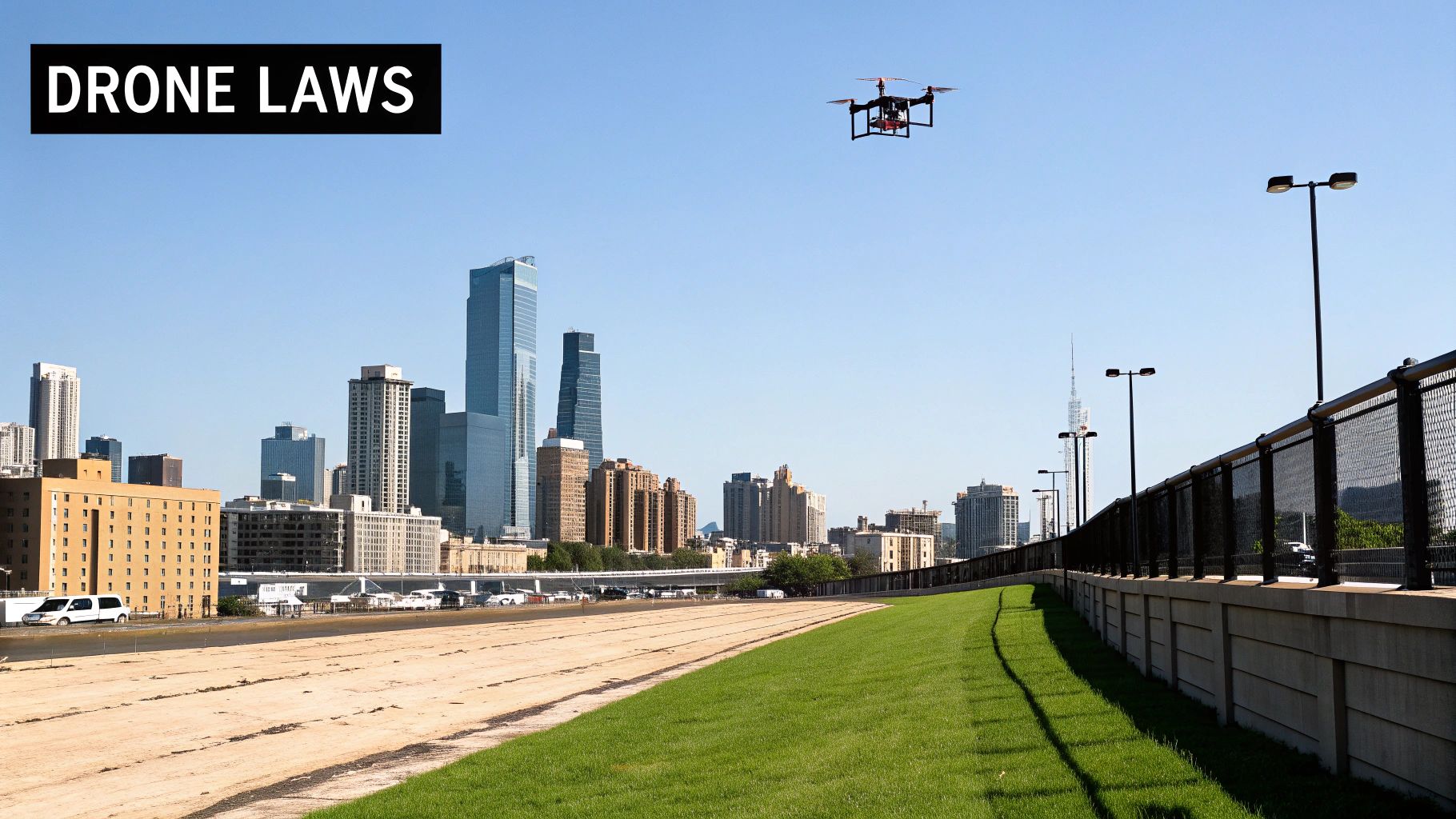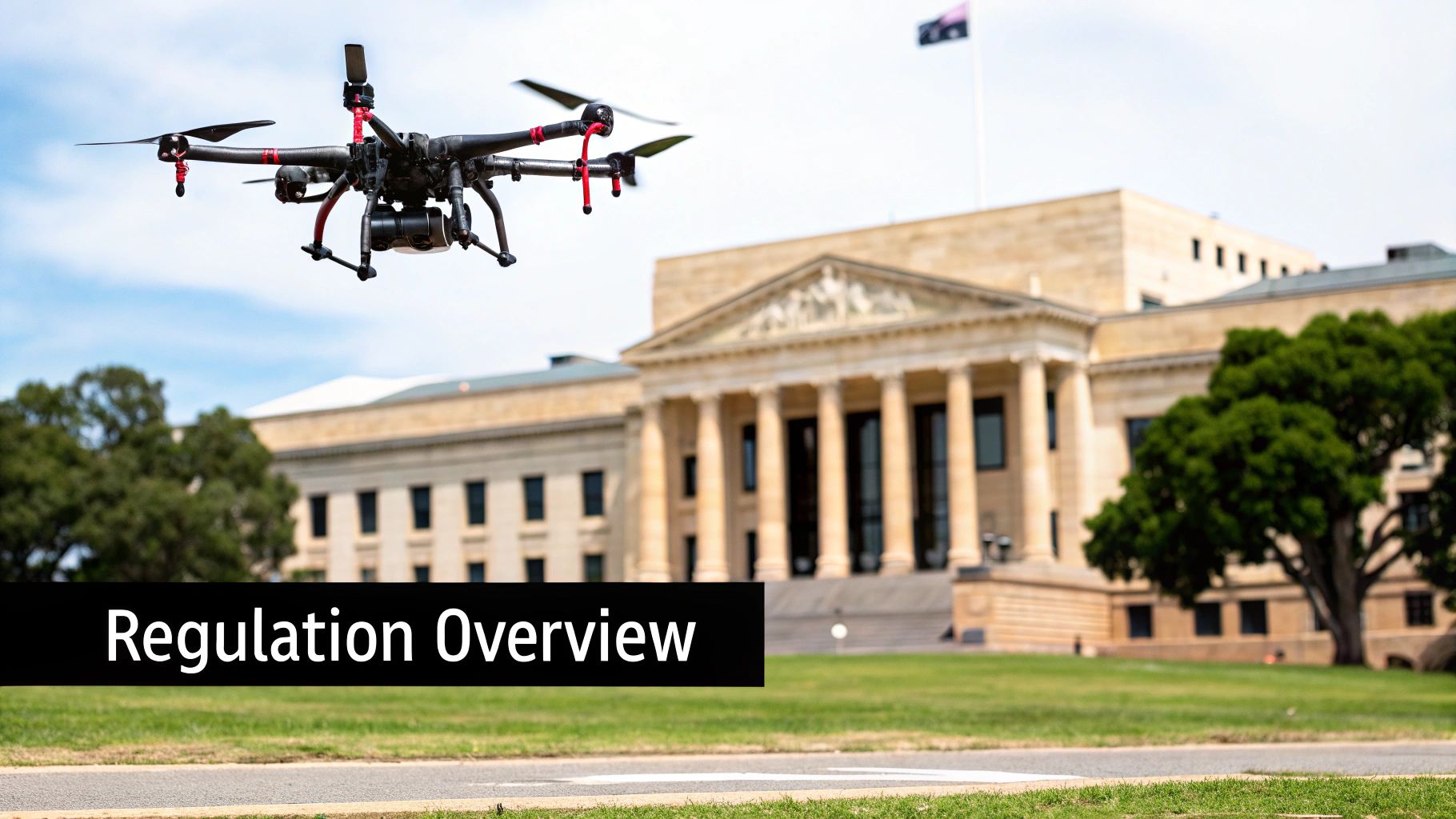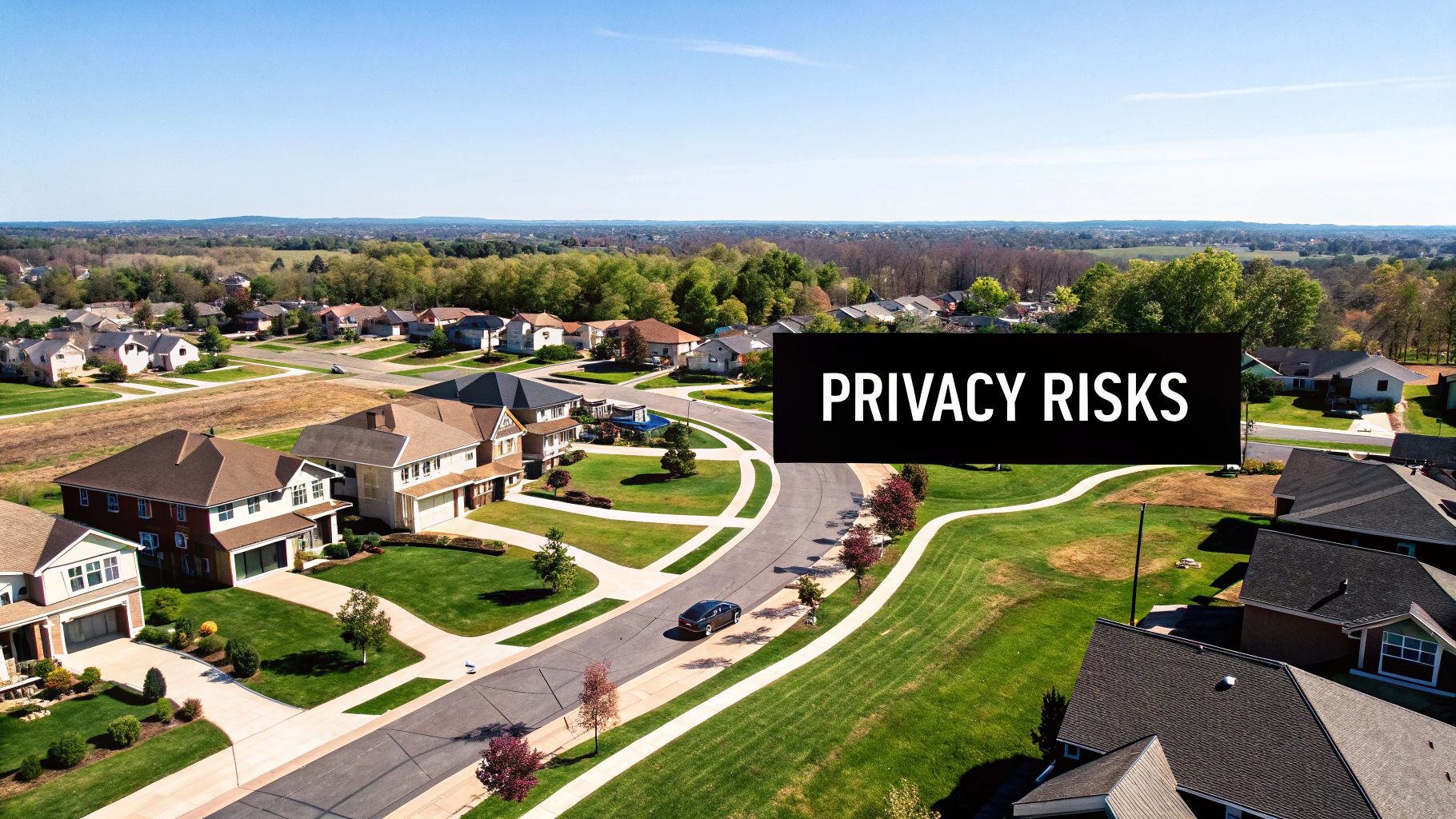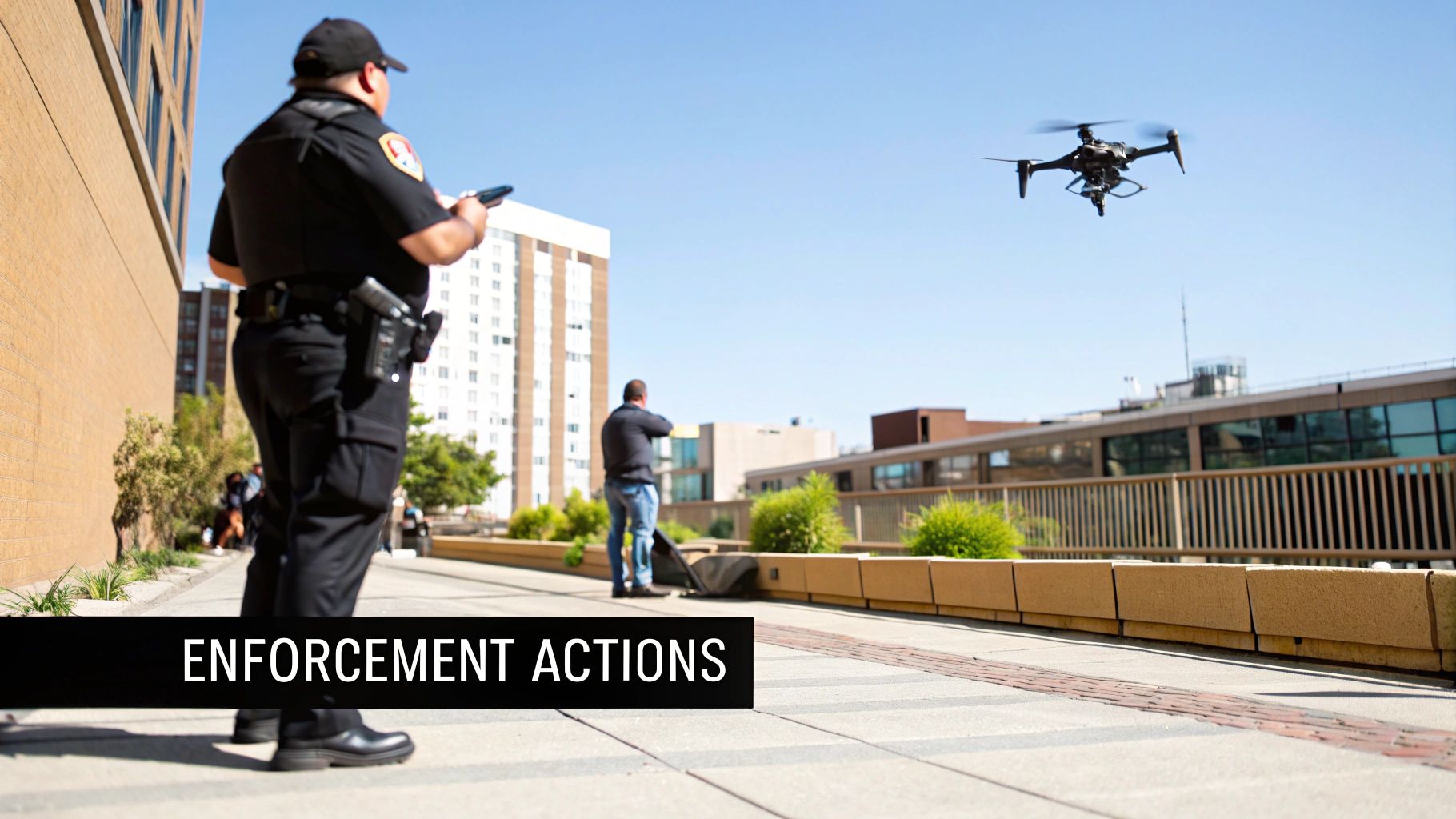Master the Drone Laws: Your Essential Compliance Guide
- James Baptiste

- Apr 16
- 13 min read
Updated: Apr 16
The Evolution of Drone Laws: From Wild West to Regulation

The early days of drone flight were much like the Wild West, with few rules governing their use. This gave enthusiasts and early adopters significant freedom. However, this lack of oversight also raised safety and privacy concerns. This period of unregulated flight underscored the need for clear guidelines to ensure responsible drone operations.
This need prompted the development of the first drone laws. Initially, these focused on reacting to incidents as they occurred. For example, some of the first regulations addressed drones flying too close to airports or other restricted areas. As drone technology advanced, these initial rules became insufficient.
The evolution of drone laws has shifted from a reactive to a proactive approach. This shift aims to encourage innovation while mitigating risks. The formation of regulatory bodies like the Federal Aviation Administration (FAA) in the U.S. and the European Aviation Safety Agency (EASA) in Europe was a crucial step toward a more structured system. The development of drone laws can be broadly categorized into phases, with major regulatory frameworks developed by organizations like the EASA and the FAA. As of 2023, these frameworks continue to shape the industry.
For instance, the FAA has been developing Beyond Visual Line of Sight (BVLOS) rules and airworthiness requirements for advanced drone operations, such as delivery services. The regulatory environment is key for expanding drone operations. Most countries still face hurdles implementing effective permit processes, which hinders broader adoption. Significant advancements are anticipated in the coming years, with countries like Taiwan and China making progress in drone law development. Learn more about this evolving landscape here.
Key Milestones in Drone Regulation
Several milestones have shaped current drone laws, influencing how we fly today. The implementation of Remote ID, for example, allows authorities to identify and track drones during flight. This addresses security and accountability concerns. Furthermore, developing rules for commercial drone operations has helped legitimize the industry and created new business opportunities.
International Variations in Drone Laws
While many countries have similar concerns regarding drone safety and privacy, specific regulations vary. Some countries have stricter rules about drone registration or where drones can fly. This highlights the importance of researching local drone laws before flying in a new location. These changing regulations, along with advancements in drone technology, are creating a future where drones play a more integrated role in our lives.
Commercial Drone Operations: Navigate Legal Requirements

Moving from recreational to commercial drone operations adds a new level of legal complexity. Understanding and following drone laws is essential for business success. These regulations cover everything from getting the right certifications to managing risk with proper insurance.
Certifications and Licensing for Commercial Pilots
For commercial drone pilots, one of the first steps is proper certification. In the United States, this means passing the Part 107 exam from the FAA. This exam covers topics like airspace rules, weather, and emergency procedures. Pilots also need to maintain their certification with recurrent training.
Insurance Requirements for Commercial Operations
Insurance is key for commercial drone operations, just like any other business. It protects your business from liabilities from accidents or damages. The specific insurance requirements depend on the type of operation and location. Carrying enough coverage is important to reduce financial risks.
Industry-Specific Regulations and Considerations
Different industries have specific drone laws. For example, commercial drone deliveries have seen impressive growth. In 2022, over 10 drone operators completed over 5,000 deliveries each, with one leading company delivering hundreds of thousands of packages. Globally, drone-delivered packages increased by 80% between 2021 and 2022, reaching almost 875,000 deliveries. By June 2023, an estimated 500,000 deliveries had already happened, with projections over 1 million for the year. Regulatory changes, like the FAA’s allowance of Beyond Visual Line of Sight (BVLOS) operations, are important for this expansion. These changes encourage wider drone use and open up new opportunities in different industries. For more detailed statistics, check out this article: Commercial Drone Deliveries Are Demonstrating Continued Momentum in 2023
Agriculture, inspection, and aerial photography each have their own rules that commercial operators must follow. This includes getting specific waivers or permits for some operations. Knowing these industry-specific drone laws is crucial for staying legally compliant.
The following table offers a general overview of commercial drone license requirements. Keep in mind, these can change and it’s crucial to consult the latest regulations in your specific region.
Commercial Drone License Requirements by Country
Country | License Type | Weight Restrictions | Operational Limitations | Renewal Requirements |
|---|---|---|---|---|
United States | Part 107 | Varies depending on operation | Restrictions on flight over people, at night, and beyond visual line of sight | Recurrent knowledge test every 24 calendar months |
Canada | Advanced or Basic Operations Certificate | <25kg for Basic, no restrictions for Advanced | Similar restrictions to the US, with variations by province | Varies depending on certificate type |
United Kingdom | Flyer ID and Operator ID | <20kg | Restrictions on proximity to airports and congested areas | Operator ID renewal every year |
Australia | Remote Pilot Licence (RePL) | Sub-2kg (excluded category), <2kg (micro), 2-7kg (small), 7-25kg (medium), >25kg (large) | Varies depending on weight category and location | 5 years |
European Union | Open, Specific, Certified categories. License requirements vary by category and country. | Varies by category | Varies by category and country. | Varies by category and country. |
This table provides a brief overview of the different regulations across several countries. The specific requirements can vary significantly, highlighting the importance of researching local regulations.
Staying Ahead of Changing Drone Laws
Drone regulations constantly change with technology. Commercial operators need to stay informed about compliance. Regularly checking for updates from regulatory bodies and joining industry forums can help ensure you’re operating legally. By adapting to changes and putting safety first, commercial drone businesses can succeed in this dynamic industry. This preparedness protects your business and contributes to safe and responsible drone industry growth.
Recreational Drone Laws That Keep You Flying Safely

For many recreational drone pilots, understanding drone laws can seem daunting. But by focusing on a few key areas, you can enjoy your hobby legally and responsibly. This boils down to registering your drone, understanding airspace restrictions, and prioritizing safety. This section simplifies the key legal considerations for recreational flyers.
Drone Registration: A Necessary First Step
Just like registering a car, most recreational drones require registration. In the United States, drones weighing over 0.55 pounds (250 grams) must be registered with the FAA. This involves providing some basic information about yourself and your drone, and paying a small registration fee. Think of it as getting a license plate for your drone, making it identifiable if needed.
Understanding Airspace Restrictions
Knowing where you can and can't fly is crucial for safe and legal drone operation. Some areas, such as airports and military bases, are strictly prohibited without prior authorization. Also, temporary flight restrictions (TFRs) can be put in place for events like sporting events or emergencies. Fortunately, various apps and websites, like B4UFLY, can help you identify these restricted areas before you fly.
This proactive approach helps you avoid unexpected fines and maintain positive relationships with local authorities. Ignoring airspace restrictions can have serious consequences, including hefty penalties and even drone confiscation.
Pre-Flight Checklist: Building Safe Habits
A pre-flight checklist is a vital habit for every recreational pilot. This ensures you've covered all the necessary steps before taking off. Key elements to include are:
Checking for airspace restrictions
Ensuring your drone's battery is fully charged
Confirming a stable GPS signal
Visually inspecting your drone for any damage
This routine promotes safe and responsible flying, minimizing the risk of accidents and legal problems. This protects your equipment, the people around you, and contributes to the responsible growth of the drone community.
Common Misconceptions and How to Avoid Them
Many new drone pilots fall prey to common misconceptions about drone laws. One example is believing that flying below a certain altitude always keeps you compliant. This isn't necessarily true. Flying over private property without permission, even at low altitudes, can still be a violation.
Another misconception is that recording anything in public is legal. Privacy laws still apply, and filming individuals without their consent can lead to legal issues. Recreational pilots must stay informed and respect the privacy of others. By understanding these common pitfalls and following drone laws, you can enjoy flying your drone responsibly and safely.
Master Airspace Restrictions and No-Fly Zones

Airspace restrictions are crucial for drone pilots. Ignoring these rules can lead to penalties, but careful planning makes them avoidable. This section will break down airspace complexities, helping you fly safely and legally.
Understanding Airspace Classifications
Airspace is divided into classes, each with unique rules. Think of it like roads – some are for local traffic, others for high-speed travel. Similarly, different airspace classes accommodate various aircraft, from small drones to large airliners. Understanding these classifications is fundamental for safe drone operations.
The following table, "Drone Airspace Classifications and Requirements," provides a detailed breakdown of airspace types, required permissions, and typical restrictions for drone operations.
Airspace Class | Description | Authorization Required | Altitude Limits | Special Requirements |
|---|---|---|---|---|
Class A | Generally above 18,000 feet | Yes | Up to 60,000 feet | Reserved for commercial air traffic. Drone operations are typically not permitted. |
Class B | Surrounds major airports | Yes | Varies, generally up to 10,000 feet | Requires explicit authorization from Air Traffic Control (ATC). |
Class C | Around smaller airports | Yes | Varies, generally up to 4,000 feet | Authorization from ATC is needed. |
Class D | Similar to Class C, but with less traffic | Yes | Varies, generally up to 2,500 feet | Contact with ATC is usually required. |
Class E | Controlled airspace not within Class A, B, C, or D | Generally not required below 400 feet | Extends from the surface upwards | Follow specific regulations for operating within Class E. |
Class G | Uncontrolled airspace | Generally not required below 400 feet | Extends from the surface to the base of overlying Class E airspace | Adhere to general drone operation rules. |
Key takeaways from this table include the increasing restrictions and authorization requirements as you move from Class G to Class A airspace. Understanding these differences is vital for planning any drone flight.
Decoding Aeronautical Charts
Aeronautical charts, while complex at first glance, are valuable tools. They visually represent airspace classifications, restricted areas, and other crucial information. Learning to read them is like having a roadmap for the sky.
Even without an aviation background, successful drone pilots learn to use these charts. Many online and print resources simplify this process. This makes it possible for anyone to master airspace restrictions, no matter their experience level.
Utilizing Reliable Airspace Restriction Data
Apps like B4UFLY provide up-to-date airspace restriction information. These are vital tools for pre-flight checks, offering real-time updates on Temporary Flight Restrictions (TFRs) due to events or emergencies. These apps can also assist in securing necessary authorizations.
By using these digital tools, drone pilots stay informed about any changes to airspace restrictions before takeoff. This proactive approach ensures flights are legal, safe, and problem-free.
The Consequences of Airspace Violations
Violating airspace restrictions has serious consequences, ranging from warnings and fines to criminal charges, especially for repeat offenses or endangering other aircraft. The FAA has reported over 2,000 drone sightings near airports since 2021, some causing flight disruptions. This highlights the importance of knowing and respecting airspace rules.
Pre-Flight Routines for Success
A solid pre-flight routine is key to avoiding airspace issues. This should always include checking for airspace restrictions using reliable apps and resources. Visualizing your flight path and considering potential hazards are also crucial for a safe and legal flight. This promotes responsible drone use and protects everyone's safety.
Privacy Laws and Your Drone: Stay Legal While Filming
Drone regulations extend beyond just airspace; they also encompass privacy. Equipping your drone with a camera introduces significant privacy implications. This means learning how to capture breathtaking footage while simultaneously respecting individual privacy and property rights. This section explores the intersection of drone flights and privacy laws, offering practical advice for ethical and legal filming.
Respecting Property Rights and Personal Privacy
Flying over someone's private property without their explicit permission raises significant privacy concerns. Before you even think about taking off, it's crucial to understand the airspace. The FAA's resources, including the Drone FAA Map, offer a wealth of information. Capturing footage of individuals without their consent, even in public areas, can also be problematic. It's similar to using a powerful telephoto lens – just because you can see something doesn't automatically give you the right to record it.
This brings us to a critical point: considering the perspective of the people being filmed. Would you be comfortable if someone were capturing footage of you in the same situation? This simple question can guide your decisions and ensure you are operating ethically.
Navigating Data Protection Laws
Data protection laws, such as the GDPR, add another layer of complexity for drone operators. These laws govern the collection, use, and storage of personal data, which includes images and videos. Capturing identifiable facial features or license plates, for example, could be considered a violation. Many professional drone operators obtain explicit permissions before filming, particularly for commercial projects. This not only protects them legally but also builds trust within the community.
Regional Differences in Privacy Expectations
Privacy expectations vary considerably across different regions and cultures. What might be acceptable in one place could be considered highly intrusive in another. This highlights the importance of researching local customs and laws before flying, especially when traveling internationally. Respecting these cultural norms fosters positive relationships and helps avoid unnecessary conflicts.
Actionable Frameworks for Ethical Drone Operation
Developing a strong ethical framework is essential for responsible drone use. Here are some practical steps you can incorporate into your pre-flight checklist:
Inform Yourself: Research local drone laws and privacy regulations before each flight.
Seek Permission: Obtain consent from property owners and individuals before filming them.
Minimize Data Collection: Only capture the footage you absolutely need. Avoid recording sensitive information like faces or license plates.
Be Transparent: If anyone asks about your drone operations, be open about your purpose and how you will use the captured footage.
Respect Privacy: Always put the privacy of others first, and avoid any intrusive filming practices.
By adhering to these guidelines, drone pilots can capture amazing footage while respecting privacy and complying with drone laws. This fosters a positive image for the drone community and ensures everyone can enjoy the benefits of this technology responsibly. This ethical approach builds trust, ensures legal compliance, and contributes to the positive growth of the drone industry.
Flying Internationally: Navigate Foreign Drone Laws
Taking your drone on an international trip opens up exciting possibilities for aerial photography. However, navigating the complexities of drone laws in different countries requires careful planning. What might be perfectly legal in your home country could be prohibited elsewhere, leading to potential confiscation of your drone or even penalties.
Research and Preparation: Your Pre-Trip Checklist
Before you even pack your drone, thorough research is essential. Begin by researching the specific drone laws of your destination. Look for information on registration requirements, permitted flight zones, and any restrictions on drone usage. When working with drones, particularly for commercial purposes, understanding data privacy laws like the CCPA is crucial.
A pre-travel checklist can help ensure you have all the required documentation. This might include proof of drone registration, your pilot license (if applicable), and possibly even permission letters from local authorities. Documenting your equipment can also help avoid issues at customs. Think of it as preparing a visa for your drone, ensuring its smooth entry into the country.
Insurance Considerations For International Flights
Just as you insure your luggage, consider insurance for your drone when traveling internationally. This protects your investment against damage, loss, or theft. Some policies also offer liability coverage, protecting you if your drone accidentally causes harm or property damage.
Navigating Customs and Temporary Importation
Bringing a drone through customs involves understanding the specific regulations of the destination country. Some countries may require temporary import permits for drones, similar to other electronic equipment. Having the correct documentation readily available can expedite the customs process and demonstrate your preparedness to officials.
Language Barriers and Interactions With Officials
If you face language barriers when interacting with foreign officials, patience and clear communication are key. Having important information, like your drone's specifications and purpose of use, translated into the local language can be incredibly helpful. Consider using translation apps like Google Translate or carrying a phrasebook.
Reliable Sources For Up-To-Date Information
Drone laws are constantly changing, so relying on current information is vital. Consult official government websites or aviation authorities in your destination country for the most up-to-date regulations. Online forums and communities dedicated to drone pilots, such as DronePilots Forum, can also provide valuable insights and experiences.
Practical Tips From Globetrotting Drone Pilots
Experienced international drone pilots offer some practical advice:
Double-check regulations: Laws can change, so verify everything before your departure.
Pack smart: Use a dedicated drone carrying case to protect your equipment during transit.
Be respectful: Drone usage can be perceived differently in various cultures. Always operate responsibly and be mindful of local sensitivities.
Stay informed: Subscribe to alerts from aviation authorities to stay updated on any temporary flight restrictions or changes in regulations.
By following these guidelines, you can confidently explore the world with your drone, capturing breathtaking aerial perspectives while respecting local laws. This careful preparation allows you to focus on the creative aspects of drone photography, knowing you are flying legally and responsibly.
The Future of Drone Laws: Stay Ahead of Compliance
The drone industry is constantly evolving, and so are the laws governing it. Understanding upcoming changes in drone laws offers a significant advantage. This section explores emerging trends, technological advancements, and practical strategies for maintaining a proactive approach to compliance.
Technological Advancements Driving Regulatory Change
Rapid technological progress is a primary driver in the evolution of drone regulations. Beyond Visual Line of Sight (BVLOS) flight, for example, holds immense potential for industries like delivery and infrastructure inspection. However, it also introduces new safety considerations that regulators must address.
Similarly, the increasing sophistication of autonomous flight capabilities necessitates clear legal frameworks for accountability and liability. As drones gain the ability to fly further with less human intervention, regulations must adapt to ensure these operations are conducted safely. This proactive approach to regulation is essential for fostering innovation while mitigating potential risks.
Remote ID: Reshaping the Drone Landscape
Remote ID, often described as a "digital license plate" for drones, represents a key development in drone regulations. This technology allows authorities to identify and track drones in flight, significantly enhancing security and accountability. Much like a driver is identified through their car's license plate, drone operators can now be held responsible for their actions.
This increased transparency and accountability is poised to shape the future of drone operations. It will facilitate better enforcement of existing drone laws and contribute to a safer airspace for all. The U.S. Government Accountability Office (GAO) highlights that the Federal Aviation Administration (FAA) is still developing resources to assist law enforcement in effectively utilizing Remote ID. This collaboration between regulatory bodies and law enforcement is vital for the successful implementation of Remote ID. The GAO reports over 2,000 drone sightings near airports since 2021, emphasizing the need for robust systems like Remote ID.
Future-Proofing Your Drone Operations
Remaining compliant in a dynamic regulatory environment demands proactive measures. Here are some practical steps to consider:
Stay Informed: Regularly consult regulatory bodies like the FAA or European Union Aviation Safety Agency (EASA) for updates. Subscribe to industry newsletters and participate in relevant online forums to stay abreast of the latest developments.
Embrace Technology: Invest in drones and software that meet current and anticipated future regulations, such as those equipped with Remote ID.
Engage with the Community: Attend industry events and network with fellow drone operators to share best practices and learn from each other's experiences.
Develop a Compliance Strategy: Establish a plan for adapting to new regulations as they emerge. This might include updating operating procedures, training personnel, and acquiring new equipment.
Emerging Opportunities for Compliant Operators
While increased regulation may appear burdensome, it also presents unique opportunities for compliant operators. By demonstrating a commitment to safety and responsibility, you can foster trust with clients and gain a competitive advantage. As the industry matures, clients will increasingly prioritize operators who adhere to the latest regulations.
DJI, a leading drone manufacturer, proactively updates its geofencing system, GEO, to align with current FAA data and regulations (as detailed in their blog post). This reflects their commitment to responsible drone operation and compliance. These updates include replacing older No-Fly Zones with Enhanced Warning Zones, providing pilots with more control and responsibility in accordance with FAA guidelines.
By staying ahead of compliance, you are not just mitigating penalties, but building a sustainable and successful drone operation. This proactive approach positions you as a leader in the drone community. This commitment to compliance ultimately benefits individual operators and the entire industry.
Ready to enhance your drone knowledge and stay ahead of the evolving regulatory landscape? Visit JAB Drone for expert insights, product reviews, and the latest news.




Comments